Improving the Bearing Capacity of Footing on Soft Soils Using Stone Columns
Ali Falsafi1 * and M. R. Motahari1
Corresponding author Email: Ali_Falsafi@yahoo.com
DOI: http://dx.doi.org/10.12944/CWE.10.Special-Issue1.123
In the present paper, the numerical analysis of stone columns in improving the bearing capacity of footing with the length of 10m, and thickness of 0.5 m in fine-grained soil is studied. The case study, stone columns group, has 3 columns which are symmetric. Two-dimensional finite element method is used for investigating the behavior of stone columns. In addition, behavior of stone column's materials and its surrounding soil has been modeled using the Mohr-Coulomb elasto-plastic constitutive model. In this analysis, the various parameters such as number of columns, influence of deformation in single column and stone column group, young modulus of the materials of stone column and soil, Poisson’s ratio of column's material and soil have been studied. Results indicate that efficiency of stone columns in soft fine-grained soil. Most important results show that operations of stone columns are faster and less costly comparing to piles.
Copy the following to cite this article:
Falsafi A, Motahari M. R. Improving the Bearing Capacity of Footing on Soft Soils Using Stone Columns. Special Issue of Curr World Environ 2015;10(Special Issue May 2015). DOI:http://dx.doi.org/10.12944/CWE.10.Special-Issue1.123
Copy the following to cite this URL:
Falsafi A, Motahari M. R. Improving the Bearing Capacity of Footing on Soft Soils Using Stone Columns. Special Issue of Curr World Environ 2015;10(Special Issue May 2015). Available from: http://www.cwejournal.org/?p=11440
Download article (pdf) Citation Manager Publish History
Select type of program for download
| Endnote EndNote format (Mac & Win) | |
| Reference Manager Ris format (Win only) | |
| Procite Ris format (Win only) | |
| Medlars Format | |
| RefWorks Format RefWorks format (Mac & Win) | |
| BibTex Format BibTex format (Mac & Win) |
Article Publishing History
| Received: | 2014-11-06 |
|---|---|
| Accepted: | 2015-12-30 |
Introduction
Construction of stone column is so common to improve soft soils such as clay, silt and silty sands which have proven to be compatible with environment (Keykhosro poor, L, 2011). Stone columns were first used in France in 1830, and they are widely used in other countries since 1950. In Iran at first it was used by the Ramming method, and since 2004 vibration technique was used in building stone columns (Etezad, M., et al, 2005), (Hughes, J.M.O and withers, N.J, 1974). In 1974 behavior of stone columns was studied for the first time. Meanwhile many numerical and laboratory tests have been used and most important one is determining the subsidence of column and its surrounding soil which is the result of applying upright tension on the ground (Tabarsaz, S, 2008). Since the rigidity of stone column is more than the soil, tension concentration and result of decreased subsidence and increasing the bearing capacity of overall ground and stone column are benefits of using this method (Lo, S.R., et al., 2010), (Kempfert, H.G., Gebreselassie, B., 2006). In another study it is reported that in the single stone column faults as a result of sag in upper column, if in stone column group, sagging occurs in lower parts of column (Alexiew, D., Brokemper, S., 2005), (Gniel, J., Bouzza, A., 2009), (Khabazian, 2010). In the present paper performance of stone columns in improvement of bearing capacity, subsidence and different parameters such as sag effect in single column and columns group, number of columns, materials and soil's elasticity modulus ratio and Poisson coefficient of stone columns materials and soil upon the degree of soil's subsidence are investigated. Numerical analysis is carried out as plane strain using ABAQUS software.
Modeling procedure with ABAQUS
Single Stone Column
Numerical analysis for clayey soil reinforced by stone column with 0.6 m diameter is carried out in order to evaluate the behavior of single stone column. Loading has only been done upon the stone column by rigid foundation. Stone column and surrounding soil modeling is a two-dimension plane strain. the mentioned model is presented in Fig1.
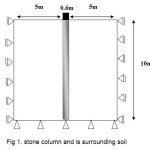 |
|
Stone column material and surrounding soil is modeled by Mohr-Coulomb. Physical and mechanical properties of stone column materials and surrounding soil are listed in Table 1. Rigid foundation applies the force by the value of 585 kPa only on the stone column. Fig 2 shows the deformation of stone column after exerting the whole load. This plot reveals that there is sagging and subsidence in upper parts of stone column. Fig 3 shows the level of sagging in column.
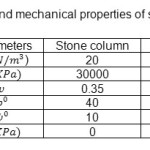 |
Table 1: Physical and mechanical properties of soil column materials Click here to View table |
 |
|
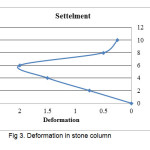 |
|
Stone Column Group
In order to investigate the behavior of stone group, a four stone column group with 0.5 diameter and whose center to center distance is from 1.2m to 3.6 m, is placed below a 10 m long rigid square foundation. Geometric characteristic of stone column group are in Fig 4 and their mechanical characteristic listed in Table 2.
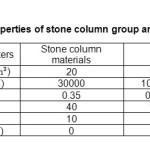 |
Table 2: Material properties of stone column group and surrounding soil Click here to View table |
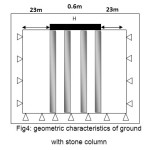 |
|
In Fig 5, behavior of each column in a group is independent from near columns and each column deforms as a single column.
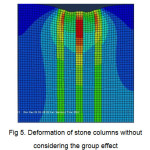 |
|
Investigation of The Effect of Different Parameters
In this part the effect of different parameters including number of columns, effect of sagging in single column and column group, distance between columns, column material and soil's elasticity ratio and the Poisson coefficient of stone column materials and by producing various models are studied as follows.
Number of Columns
Subsidence variations of column caps with changing the number of columns are shown in Fig 6. Increasing the number of columns leads to more restriction of middle columns, thus decrease of subsidence. Numerical analyses have been performed for 3, 5, 7 and 9 stone columns with the diameter of 0.6 m. The pressures forced in all cases are the same and equal to 325 kPa. Number of columns, applied forces and the subsidence that occurs by these forces are listed in Table 3. As shown in figure 6, Subsidence decreases by increasing the number of stone columns.
Table 3: Comparison of the intensive load and subsidence of stone columns
|
Number of columns |
subsidence (m) |
Intensive load (kN) |
|
3 |
0.274 |
975 |
|
5 |
0.23 |
1755 |
|
7 |
0.173 |
2535 |
|
9 |
0.147 |
3375 |
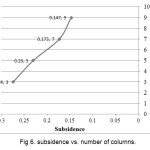 |
|
Effects of the Change in Elasticity Module
Fig 7 shows the effect of changes in elasticity module of stone column material and clay assuming that soil's elasticity module is constant to 5 MPa for load of 165 kPa. As expected, increasing the ratio of stone column's elasticity module over soil's elasticity module cause decrease in subsidence of the soil reinforced with stone column.
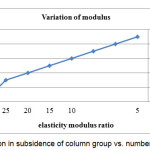 |
|
Piosson Ratio
Poisson ratio of stone column materials and soil is one of factors that causes the subsidence of soils with stone columns. Fig 8 shows the effect of changing in Poisson coefficient of stone column materials and soils for 280 kPa weight.
Stone column material's Poisson coefficient varies from 0.2 to 0.35. And Poisson coefficient of soil varies from 0.3 to 0.45. As it can be seen in the Fig 8, increasing the stone material's Poisson coefficient has a slight influence on decrease of subsidence of reinforced ground, compared to increasing surrounding soil's Poisson coefficient.
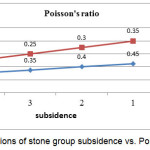 |
|
Effect of Stone Column Length
Fig 9 shows the influence of stone column’s length for 170 k Pa weight. Stone column length varies evenly in these analyses from 2 to 10 meters. A series of analyses are performed on stone column group that has 3 columns with 0.6m diameter and the center to center distance of 1.2 m. According to Fig 9, numerical analyzes results indicate that decrease of subsidence on top and bottom of columns is due to increase of column lengths. In addition, subsidence decrease rate reduces due to increase of column length from 0.6m to 10 m.
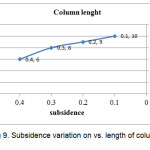 |
|
Conclusion
In this paper, by using ABAQUS, behavior of stone columns and the effect of important parameters on stone column- soil system were studied and the following results were obtained:
- Numerical analysis results indicate that sagging of columns which leads them to fail, occurs in upper part of column. Sagging of inner columns occurs in lower parts than side columns.
- Increasing the stone column's elasticity module compared to soil's module, decreases the subsidence of grounds with stone columns.
- Increasing the number of stone columns results in more inclosing if middle columns which decreases the subsidence by 50%.
- Poisson coefficient of soil and stone column is one of the factors that reduces the subsidence of grounds with stone columns however the effect of Poisson coefficient is low.
- Numerical analyses about the influences of stone column's lengths indicate that increasing the length of column group reduces the subsidence of the ground.
References
- Keykhosro poor, L, (2011), "study of effect of coated stone column on reinforcing soft soils with numerical analysis", Master dissertation, Amirkabir University, Tehran..
- Etezad, M., Hanna, A.M. and Ayadat.T., (2005), "Numerical model for group of Stone columns", Proc. 73rd Annual Meeting of ICOLD, Tehran. Iran No. 097-0T.
- Hughes, J.M.O and withers, N.J, "Reinforcing of Soft cohesive soils with stone columns" Ground Engineering, Vo11.N.3, 1974.PP42-49
- Tabarsaz, S, (2008), "numerical analysis of mechanical behavior for grounds with stone columns". Master dissertation, Amirkabir University, Tehran.
- Lo, S.R., Zhang, R., Mak, J., (2010), “Geosynthetic-Encased Stone Columns in Soft Clay: a Numerical Study,” Geotextiles and Geomembranes, No. 28, 292-302.
- Kempfert, H.G., Gebreselassie, B., (2006), “Excavations and Foundations in Soft Soils,” Springer, p.p. 474-481.
- Alexiew, D., Brokemper, S., (2005), “Geotextile Encased Columns(Gec): Load Capacity, Geotextile Selection and Pre-Design Graphs,”Gsp131, Contemporary Issues in Foundation Engineering, ASCE.
- Gniel, J., Bouzza, A., (2009), “Improvement of Soft Soils Using Geogrid Encased Stone Columns,” Geotextiles and Geomembranes, No. 27, p.p. 167-175.
- Khabazian, (2010), “3D Numerical Analyses of Geosynthetic Encased Stone Columns,” ASCE Proc.Conference, p.p. 201-208







